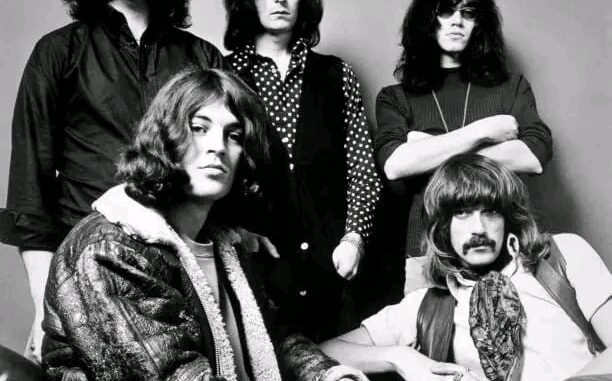
Deep Purple Ignites Rock’s Fiery Soul — The Timeless Titans Who Shaped Music’s Electric Legacy
Few names in the history of rock music carry as much weight, respect, and raw power as Deep Purple. Emerging in the late 1960s, the British band didn’t just play rock — they defined it, helping to forge the sound and spirit of hard rock and heavy metal. From their thunderous riffs to their electrifying live performances, Deep Purple’s journey is one of bold experimentation, unbreakable passion, and an enduring influence that continues to set stages ablaze across generations.
At a time when psychedelic rock was the dominant force, Deep Purple dared to go heavier, faster, and louder. Their 1970 breakthrough album Deep Purple in Rock was a declaration of intent — a sonic explosion that combined classical precision with rock fury. The album introduced the world to a lineup that would become legendary: Ritchie Blackmore on guitar, Ian Gillan on vocals, Roger Glover on bass, Jon Lord on keyboards, and Ian Paice on drums. Together, they crafted a sound that was both chaotic and controlled, aggressive yet elegant — a perfect storm of virtuosity and volume.
Then came Machine Head (1972), the album that immortalized them. From the roaring opener “Highway Star” to the immortal riff of “Smoke on the Water,” it cemented Deep Purple’s status as rock gods. That iconic riff, inspired by a fire at a casino in Montreux, Switzerland, became one of the most recognizable sounds in music history. It wasn’t just a song — it was an anthem that captured the essence of rock: rebellion, improvisation, and pure adrenaline. With Machine Head, Deep Purple didn’t just dominate the charts; they created a blueprint that countless bands would follow.
Deep Purple’s magic lay in their musicianship. Ritchie Blackmore’s guitar solos were ferocious yet melodic, blending classical scales with blistering speed. Jon Lord, with his Hammond organ, added a rich, orchestral texture that set them apart from every other rock band. Meanwhile, Ian Gillan’s soaring vocals and theatrical delivery gave the band a voice as powerful as its instruments. Their live performances, especially captured on Made in Japan (1972), remain a masterclass in rock showmanship — a raw, unfiltered celebration of musical brilliance.
But Deep Purple’s story isn’t one of smooth sailing. The band endured frequent lineup changes, creative tensions, and evolving musical directions. After Gillan and Glover left in 1973, David Coverdale and Glenn Hughes stepped in, leading to albums like Burn and Stormbringer, which infused funk and soul into their heavy sound. Later, Blackmore’s departure paved the way for Tommy Bolin, whose tenure was tragically short-lived. Yet through every transformation, Deep Purple’s core remained — the drive to push rock’s boundaries.
The band’s revival in the mid-1980s with the classic lineup brought a new wave of energy. Songs like “Perfect Strangers” reminded fans that Deep Purple still had fire in their veins. Even as musical trends shifted — from punk to grunge to digital pop — Deep Purple remained steadfast, evolving without ever compromising their essence. They weren’t chasing relevance; they were creating it.
Over five decades later, Deep Purple’s influence is undeniable. Bands from Metallica to Iron Maiden, from Van Halen to Dream Theater, have all drawn from their sonic legacy. Their fusion of technical mastery and raw power laid the groundwork for heavy metal’s evolution. Few groups can claim to have inspired both the guitar virtuosity of the 1980s and the progressive experimentation of the 1990s.
In 2016, their long-overdue induction into the Rock and Roll Hall of Fame was more than just an award — it was recognition of their immeasurable contribution to music history. Even today, with Ian Paice, Roger Glover, and Ian Gillan carrying the torch, Deep Purple continues to tour and record, proving that their fire still burns bright. Albums like Whoosh! (2020) and Turning to Crime (2021) show a band still curious, still adventurous, and still alive in every sense.
What makes Deep Purple truly timeless is their duality — the fusion of intellect and instinct. Their music is as much about feeling as it is about technique. Whether it’s the cinematic drama of “Child in Time,” the groove-laden swagger of “Black Night,” or the infectious energy of “Space Truckin’,” their songs transcend eras. They remind listeners that rock isn’t just a genre — it’s a force, a statement, a way of life.
Deep Purple didn’t just ignite rock’s fiery soul; they became its eternal flame. Their legacy isn’t confined to records or awards — it lives in every riff that shakes an arena, in every fan who picks up a guitar, and in every moment when music becomes more than sound. For half a century and counting, Deep Purple has proven that true rock and roll never fades — it evolves, it burns, and it inspires forever.
Leave a Reply